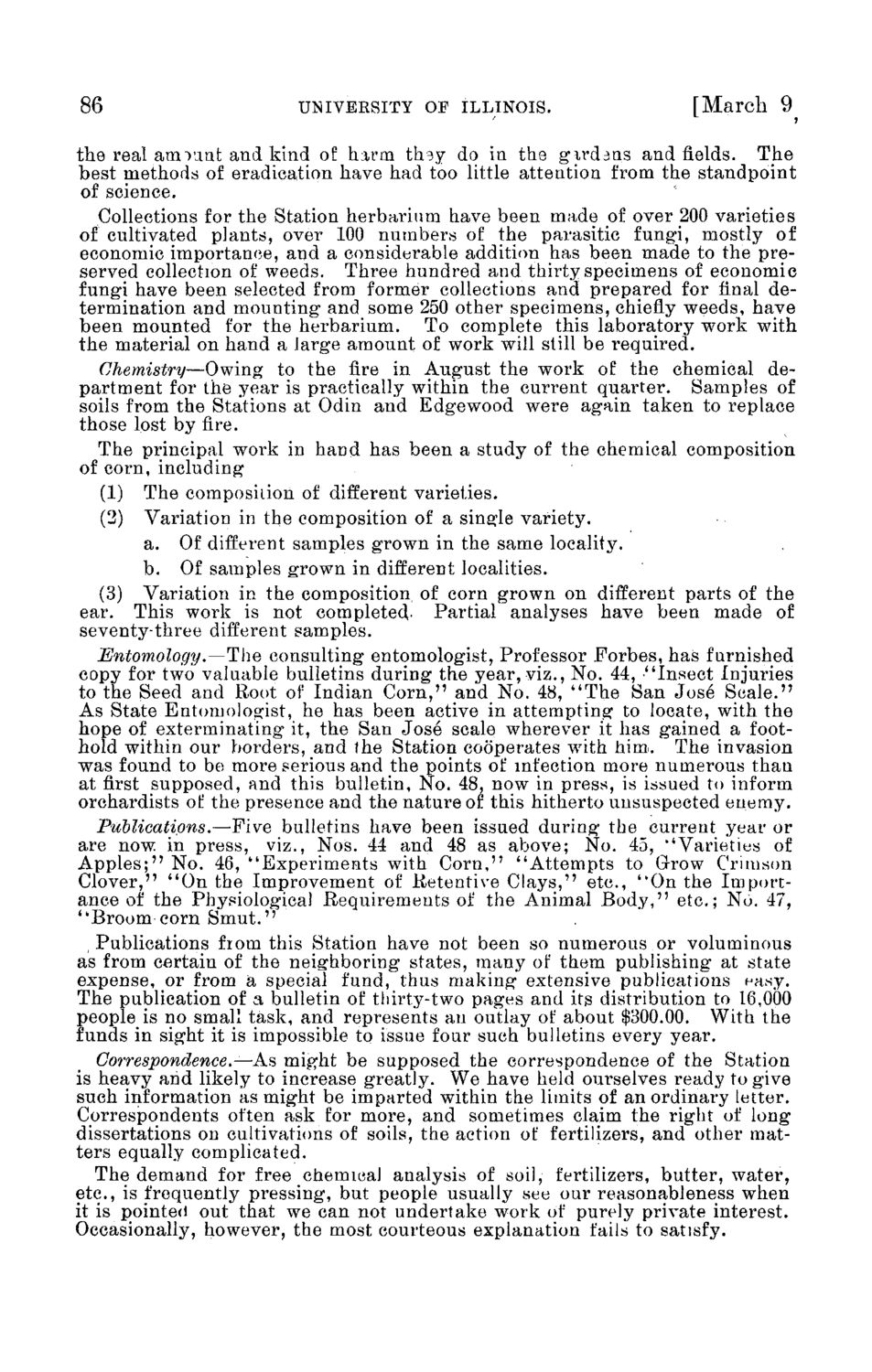| |
| |
Caption: Board of Trustees Minutes - 1898
This is a reduced-resolution page image for fast online browsing.

EXTRACTED TEXT FROM PAGE:
86 UNIVERSITY O F I L L I N O I S . [March 9 the real amount and kind of harm they do in the girdans and fields. The best methods of eradication have had too little attention from the standpoint of science. Collections for the Station herbarium have been made of over 200 varieties of cultivated plants, over 100 numbers of the parasitic fungi, mostly of economic importance, and a considerable addition has been made to the preserved collection of weeds. Three hundred and thirty specimens of economic fungi have been selected from former collections and prepared for final determination and mounting and some 250 other specimens, chiefly weeds, have been mounted for the herbarium. To complete this laboratory work with the material on hand a large amount of work will still be required. Chemistry—Owing to the fire in August the work of the chemical department for the year is practically within the current quarter. Samples of soils from the Stations at Odin and Edgewood were again taken to replace those lost by fire. The principal work in hand has been a study of the chemical composition of corn, including (1) The composiiion of different varieties. (2) Variation in the composition of a single variety. a. Of different samples grown in the same locality. b. Of samples grown in different localities. (3) Variation in the composition of corn grown on different parts of the ear. This work is not completed,- Partial analyses have been made of seventy-three different samples. Entomology.—The consulting entomologist, Professor Forbes, has furnished copy for two valuable bulletins during the year, viz., No. 44, "Insect Injuries to the Seed and Root of Indian Corn," and No. 48, "The San Jose Scale." As State Entomologist, he has been active in attempting to locate, with the hope of exterminating it, the San Jose scale wherever it has gained a foothold within our borders, and the Station cooperates with him. The invasion was found to be more serious and the points of infection more numerous than at first supposed, and this bulletin, No. 48, now in press, is issued to inform orchardists of the presence and the nature of this hitherto unsuspected enemy. Publications.—Five bulletins have been issued during the current year or are now in press, viz., Nos. 44 and 48 as above; No. 45, * 'Varieties of Apples;" No. 46, "Experiments with Corn," "Attempts to Grow Crimson Clover," "On the Improvement of Retentive Clays," etc., "On the Importance of the Physiological Requirements of the Animal Body," etc.; No. 47, "Broom corn Smut." Publications fiom this Station have not been so numerous or voluminous as from certain of the neighboring states, many of them publishing at state expense, or from a special fund, thus making extensive publications easy. The publication of a bulletin of thirty-two pages and its distribution to 16,000 people is no small task, and represents an outlay of about $300.00. With the funds in sight it is impossible to issue four such bulletins every year. Correspondence.—As might be supposed the correspondence of the Station is heavy and likely to increase greatly. We have held ourselves ready to give such information as might be imparted within the limits of an ordinary letter. Correspondents often ask for more, and sometimes claim the right of long dissertations on cultivations of soils, the action of fertilizers, and other matters equally complicated. The demand for free chemical analysis of soil, fertilizers, butter, water, etc., is frequently pressing, but people usually see our reasonableness when it is pointed out that we can not undertake work of purely private interest. Occasionally, however, the most courteous explanation fails to satisfy.
| |